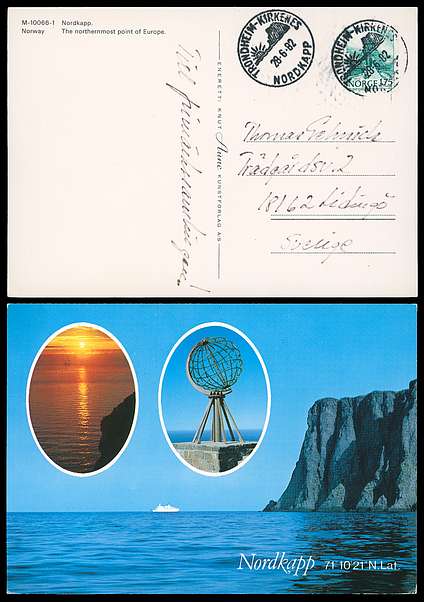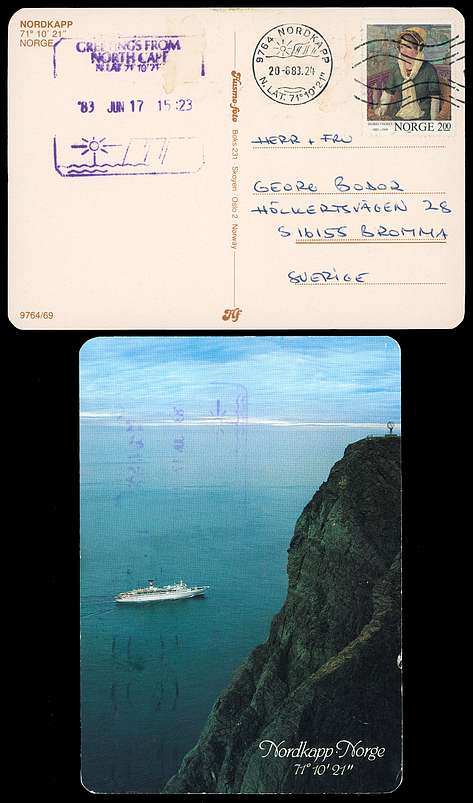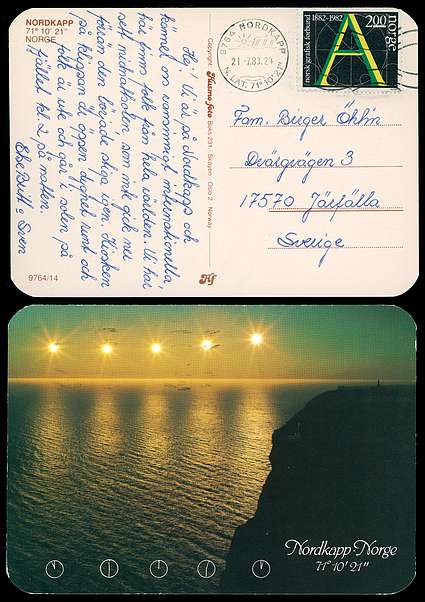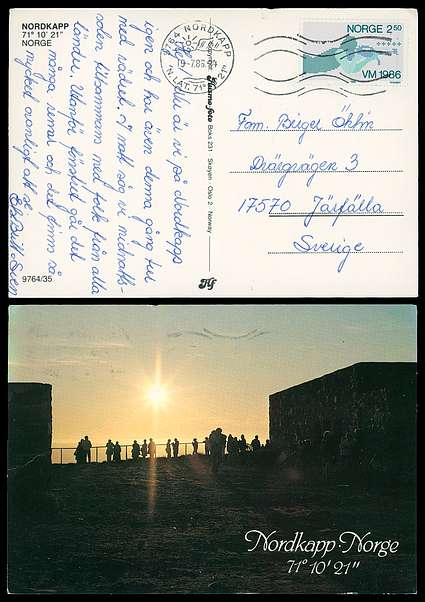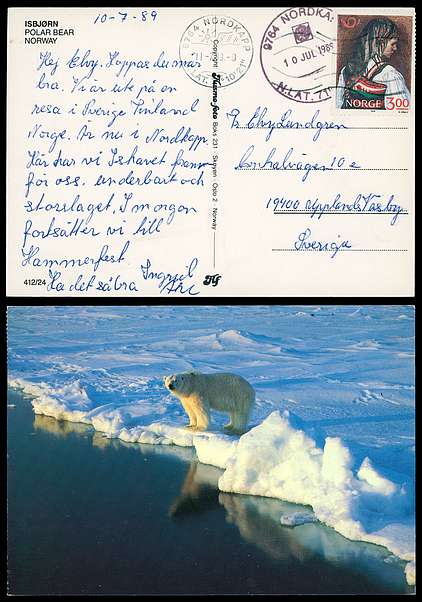| Arctic Region Covers |
| Item # |
|
US$ | ||
| 249988 |
Scott #B59 [1957 25+10 øre green Nordkapp semi-postal] (VF) solo use on 12 July 1960 tourist picture post card (monument at Nordkapp to Louis Philippe of Orleans, later King of France (1830-1848), who visited Nordkapp in 1795 while in exile) sent to Sweden. NORDKAPP illustrated handstamped cancellation; Superb strike on stamp, also Superb strike as side cancellation. Multiple types of this postmark exist; compare carefully. Correct 25 øre franking for Nordic post card rate (1 Jan 1956 - 30 June 1962). Even though Sweden is right next door, Nordkapp covers and cards to Sweden are remarkably unusual; I was lucky to obtain a small group from a collection built in Sweden. This stamp is hard to find as a correct, non-philatelic solo use on cover or card and especially for the Nordic post card rate. The single used stamp itself is a somewhat scarce stamp; it has a 2025 Scott value of $6.25. Very attractive example.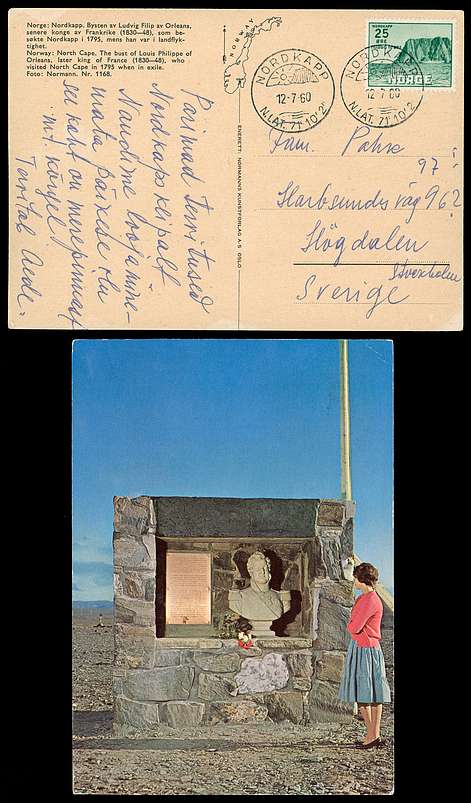 ACTUAL item. |
18.00 |
||
| 249990 |
Scott #360 [1958 25 øre emerald green Olav V] (VF) solo use on tourist picture post card (Hammerfest area midnight sun) to Sweden. The dating and cancellations on this card are a odd. The stamp has a town cancellation "LØN.....L" (In the 1969 handbook, the only LØN... town/village name is LONNINGDAL, but that seems a bit long for this postmark device) dated 12 July 1961 and there is a NORDKAPP pictorial handstamped side postmark (slightly doubled) that appears to be dated 15 July 1961. Multiple types of this Nordkapp postmark exist; compare carefully. I cannot explain why the card bears two very difference cancellations -- and if one of them is Lonningdal, that is 2240 km road distance from Nordkapp! I hope somebody will find the answer to this puzzle. Correct 25 øre franking for Nordic post card rate (1 Jan 1956 - 30 June 1962). Even though Sweden is right next door, Nordkapp covers and cards to Sweden are remarkably unusual; I was lucky to obtain a small group from a collection built in Sweden.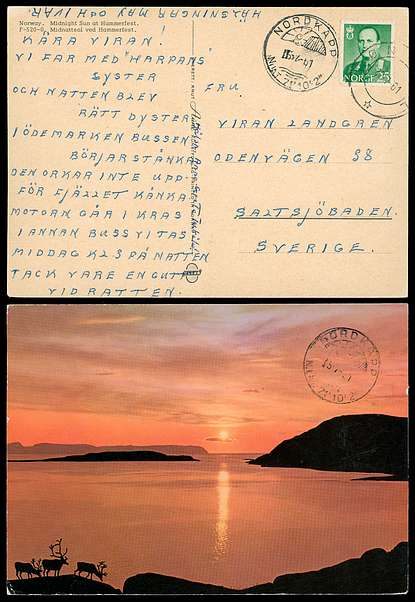 ACTUAL item. |
5.00 |
||
| 249991 |
Scott #360 [1958 25 øre emerald green Olav V] (VF) solo use on tourist picture post card (six inset Nordkapp scenes) to Sweden, with NORDKAPP 10 July 1961 pictorial handstamped F-VF cancellation on stamp and VF side postmark. Multiple types of this Nordkapp postmark exist; compare carefully. Correct 25 øre franking for Nordic post card rate (1 Jan 1956 - 30 June 1962, but stamp issued 6 May 1958). Even though Sweden is right next door, Nordkapp covers and cards to Sweden are remarkably unusual; I was lucky to obtain a small group from a collection built in Sweden.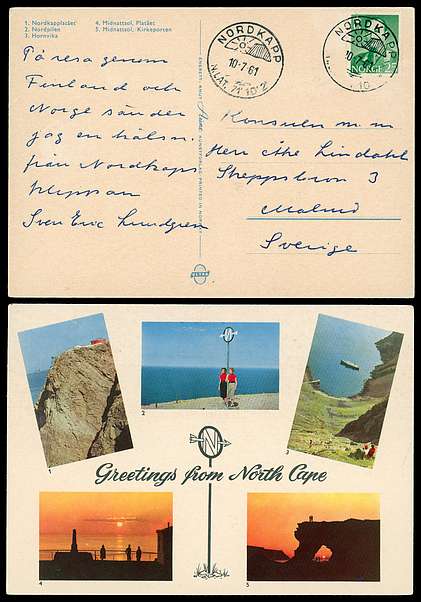 ACTUAL item. |
8.00 |
||
| 249989 |
Scott #B60 [1957 35+10 øre carmine Nordkapp semi-postal] (VF) solo use on 3 July 1962 tourist picture post card (Nordkapp visitor hall during midnight sun) sent to Sweden. NORDKAPP illustrated handstamped cancellation; VF strike on stamp. Multiple types of this postmark exist; compare carefully. Correct 35 øre franking for Nordic post card rate (1 July 1962 - 15 Nov 1964). Used on the THIRD DAY OF THIS POSTAL RATE. Even though Sweden is right next door, Nordkapp covers and cards to Sweden are remarkably unusual; I was lucky to obtain a small group from a collection built in Sweden. This stamp is hard to find as a correct, non-philatelic solo use on cover or card and especially for the Nordic post card rate. The single used stamp itself is a somewhat scarce stamp; it has a 2025 Scott value of $7.50. Very attractive example.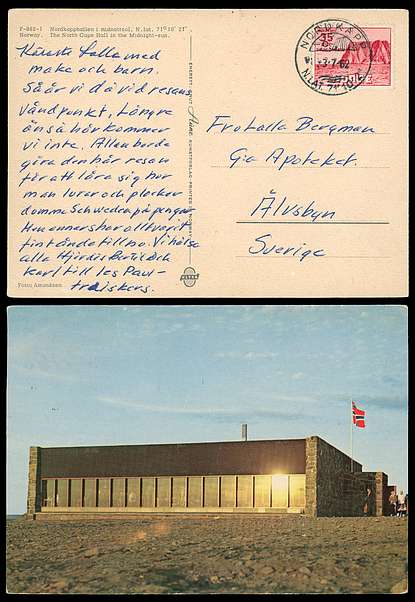 ACTUAL item. |
18.00 |
||
| 249362 |
SVALBARD / SPITZBERGEN "NY-ÅLESUND / [latitude] / SVALBARD" 11 July 1964 cancellations on philatelic cover with stamps of the era. Pink "WORLDS NORTHERNMOST COMMUNITY / KINGSBAY 79 NORTH / SVALBARD" handstamped cachet picturing a seal.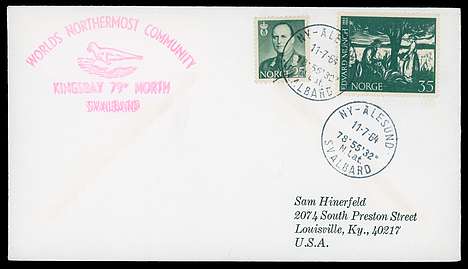 ACTUAL item. |
6.00 |
||
| 249992 |
Scott #423 Non-Fluorescent [1963 40 øre carmine Rock Carvings] (VF) solo use on tourist picture post card (midnight sun at Nordkapp) to Sweden, with F-VF NORDKAPP 17 July 1966 pictorial handstamped cancellation on stamp and F-VF side postmark. Multiple types of this Nordkapp postmark exist; compare carefully. Correct 40 øre franking for Nordic post card rate (16 Nov 1964 - 28 Feb 1968). Even though Sweden is right next door, Nordkapp covers and cards to Sweden are remarkably unusual; I was lucky to obtain a small group from a collection built in Sweden.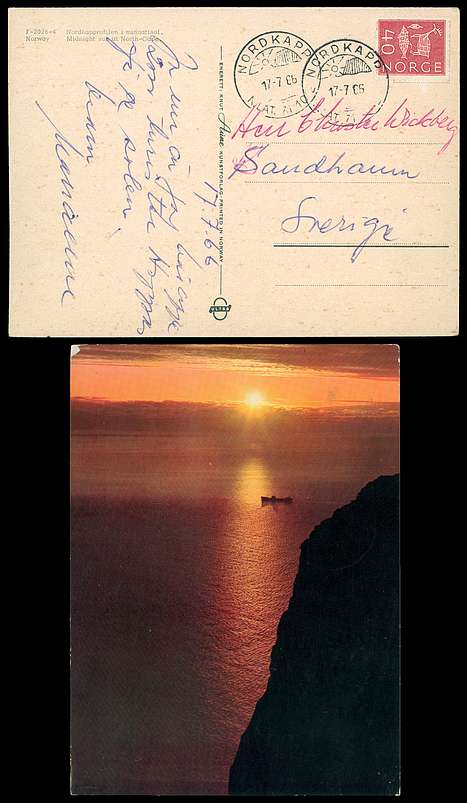 ACTUAL item. |
8.00 |
||
| 249995 |
Scott #423 Non-Fluorescent [1963 40 øre carmine Rock Carvings] (VF) solo use on tourist picture post card (5 Nordkapp scenes) to Sweden, with Superb NORDKAPP (without post code) 19 July 1967 pictorial MACHINE cancellation. Multiple types of this Nordkapp postmark exist; compare carefully. Minor aging at lower left corner. Correct 40 øre franking for Nordic post card rate (16 Nov 1964 - 28 Feb 1968). Even though Sweden is right next door, Nordkapp covers and cards to Sweden are remarkably unusual; I was lucky to obtain a small group from a collection built in Sweden.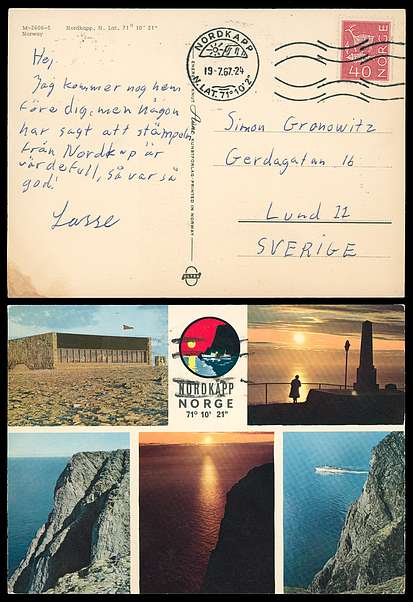 ACTUAL item. |
10.00 |
||
| 249013 |
423, 430, 463 All Fluorescent [1967 and 1968 Rock Carvings: 40 dark carmine, 90 blue, 40 øre greenish blue] (VF) on attractive 15 September 1974 cover mailed aboard the M/S NORDNORGE and signed by the ship captain, canceled with the SVALBARDRUTA (Svalbard Route) pictorial ship cancellation, sent to the U.S. Because this route ran from mainland Norway to Svalbard (Spitzbergen), we can reasonably assume that this cover did enter Svalbard / Spitzbergen waters, but that it was not landed or sent from there. Very attractive and colorful franking all with values from the same popular / topical (marine mammals, fish, animals, early people, archeology) definitive design.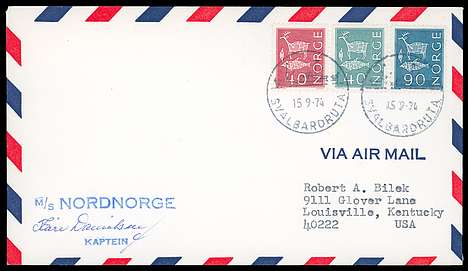 ACTUAL item. |
12.00 |
||
| 249997 |
Scott #715 Yellow Fluor [1978 1.00 kr green Austrat Manor] (VF) solo use on tourist picture post card (Nordkapp area "Arch at Scarsvåg", midnight sun) to Sweden, with Superb NORDKAPP (with post code, with inner ring at top) 9 July 1978 pictorial MACHINE cancellation. Multiple types of this Nordkapp postmark exist; compare carefully. The placeholder slug in the date stuck up high enough to be printed. Correct 1.00 kr franking for Nordic post card rate (1 March 1975 - 28 Feb 1981). Even though Sweden is right next door, Nordkapp covers and cards to Sweden are remarkably unusual; I was lucky to obtain a small group from a collection built in Sweden. ACTUAL item. |
8.00 |
||
| 249998 |
Scott #698 [1977 1.00 kr brown "Constitutionen" (first Norwegian steamship)] (VF) solo use on tourist picture post card (Nordkapp 4 scenes) to Sweden, with VF NORDKAPP (with post code, with inner ring at top) 18 July 1979 pictorial MACHINE cancellation. Multiple types of this Nordkapp postmark exist; compare carefully. Correct 1.00 kr franking for Nordic post card rate (1 March 1975 - 28 Feb 1981). Even though Sweden is right next door, Nordkapp covers and cards to Sweden are remarkably unusual; I was lucky to obtain a small group from a collection built in Sweden.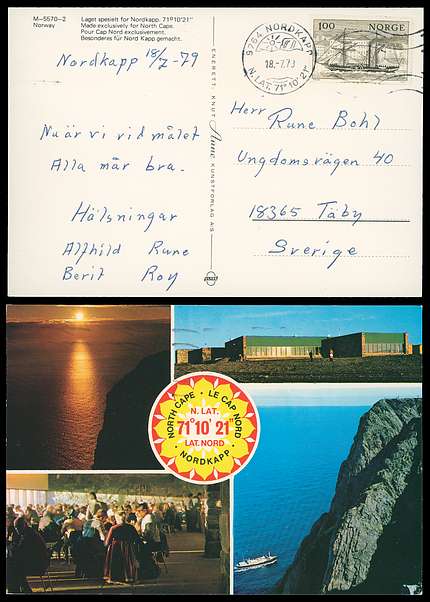 ACTUAL item. |
7.00 |
